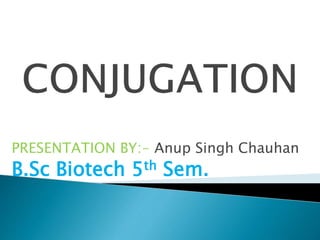Conjugation
•Télécharger en tant que PPTX, PDF•
40 j'aime•39,774 vues
Basic concept about conjugation.
Signaler
Partager
Signaler
Partager

Contenu connexe
Tendances
Tendances (20)
Similaire à Conjugation
Similaire à Conjugation (20)
Pertemuan 2. history of genetics Bu Rani Wulandari

Pertemuan 2. history of genetics Bu Rani Wulandari
Discovery of dna as the universal genetic material

Discovery of dna as the universal genetic material
Dernier
Dernier (20)
Unlocking the Potential: Deep dive into ocean of Ceramic Magnets.pptx

Unlocking the Potential: Deep dive into ocean of Ceramic Magnets.pptx
Raman spectroscopy.pptx M Pharm, M Sc, Advanced Spectral Analysis

Raman spectroscopy.pptx M Pharm, M Sc, Advanced Spectral Analysis
TEST BANK For Radiologic Science for Technologists, 12th Edition by Stewart C...

TEST BANK For Radiologic Science for Technologists, 12th Edition by Stewart C...
Forensic Biology & Its biological significance.pdf

Forensic Biology & Its biological significance.pdf
Labelling Requirements and Label Claims for Dietary Supplements and Recommend...

Labelling Requirements and Label Claims for Dietary Supplements and Recommend...
fundamental of entomology all in one topics of entomology

fundamental of entomology all in one topics of entomology
Asymmetry in the atmosphere of the ultra-hot Jupiter WASP-76 b

Asymmetry in the atmosphere of the ultra-hot Jupiter WASP-76 b
VIRUSES structure and classification ppt by Dr.Prince C P

VIRUSES structure and classification ppt by Dr.Prince C P
Discovery of an Accretion Streamer and a Slow Wide-angle Outflow around FUOri...

Discovery of an Accretion Streamer and a Slow Wide-angle Outflow around FUOri...
All-domain Anomaly Resolution Office U.S. Department of Defense (U) Case: “Eg...

All-domain Anomaly Resolution Office U.S. Department of Defense (U) Case: “Eg...
Chromatin Structure | EUCHROMATIN | HETEROCHROMATIN

Chromatin Structure | EUCHROMATIN | HETEROCHROMATIN
Pests of mustard_Identification_Management_Dr.UPR.pdf

Pests of mustard_Identification_Management_Dr.UPR.pdf
Disentangling the origin of chemical differences using GHOST

Disentangling the origin of chemical differences using GHOST
Stunning ➥8448380779▻ Call Girls In Panchshil Enclave Delhi NCR

Stunning ➥8448380779▻ Call Girls In Panchshil Enclave Delhi NCR
❤Jammu Kashmir Call Girls 8617697112 Personal Whatsapp Number 💦✅.

❤Jammu Kashmir Call Girls 8617697112 Personal Whatsapp Number 💦✅.
Hire 💕 9907093804 Hooghly Call Girls Service Call Girls Agency

Hire 💕 9907093804 Hooghly Call Girls Service Call Girls Agency
Conjugation
- 1. PRESENTATION BY:- Anup Singh Chauhan B.Sc Biotech 5th Sem.
- 2. Conjugation is the transfer of genetic material between bacterial cells of opposite mating types that are in physical contact with each other. OR A process in which DNA is transferred from a bacteria donor cell to recipient cell by cell-to-cell contact.
- 3. Discovery: Joshua Lederberg & Edward Tatum (1946). They experimented with two auxotrophic strains of E.coli K12 denoted by Strain A and Strain B. STRAIN A (met-bio- thr+ leu+ thi+) and STRAIN B (met+ bio+ thr-leu- thi-) were plated on minimal medium and incubated overnight (CONTROL), no growth observed. Also STRAIN A and B were mixed together and when plated on minimal medium resulted in prototrophs.
- 5. The evidence for cell to cell contact was provided by Bernard Davis (1950). The two arms of the U tube are separated by a filter. On the right side is medium containing auxotrophic Strain A while on the left side is medium containing auxotrophic Strain B. The filter allows only the medium to move to-and- fro but not the cells on either side. When culture was plated from both sides on minimal medium, no prototroph growth was observed as in Lederberg and Tatum’s experiment.
- 7. Donor cell produce a pilus. Pilus attaches to recipient cell and brings the two cells together. only single strand of plasmid is then transferred to the recipient cell. Both the cells synthesis a complementary strand to produce double stranded circular plasmid and also produce pilus. Both cells are now viable donor.
- 9. In 1953, William Hayes determined that genetic transfer occurred in one direction. One cell acts as donor, and the other cell acts as the recipient. Cells that can donate the DNA to other cells are F+ (male) Cells that can receive the DNA from other cells are F- (female).
- 10. Wikipedia www.ncbi.nlm.nih.gov vle.du.ac.in
